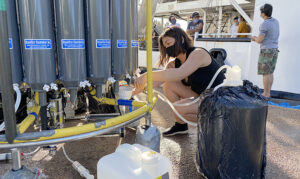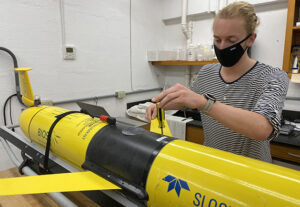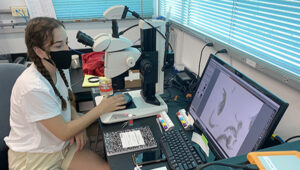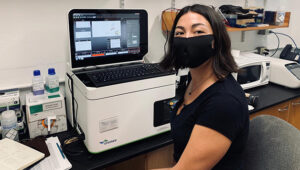‘A Fantastic Boost for My Career’

During her internship at BIOS this fall, Naomi Villiot took ocean water samples using a CTD rosette (CTD is an acronym for Conductivity, Temperature, and Depth, and it is a primary oceanographic tool for determining essential physical properties of sea water). Villiot was the AXA XL U.K. BIOS Research Intern and one of three students sponsored by the U.K. Associates of BIOS.
Naomi Villiot knew the path to research abroad during a global health crisis wouldn’t be easy or simple. However, “after a great deal of paperwork, navigating canceled flights, virus testing, and isolation for days upon arrival in Bermuda in September, I have been able to continue with my research,” said Villiot, who hails from a small island in France and studies at a British university.
The payoff, she said, has been worth the precautionary measures and inevitable research slowdowns: she plans to complete a chapter of her doctoral research on phytoplankton during her 12 weeks on the island.
Villiot, 25, is at BIOS as an AXA XL U.K. BIOS Research Intern, named for the reinsurance company that has funded the internship for undergraduate and graduate students since 2016.
Fellow interns Jonny Chapman, 25, and Maisie Smith, 21, received partial support through the U.K. Associates of BIOS.
This month, they recalled their experiences this fall as interns at BIOS.

Jonny Chapman worked on robotic gliders with his mentor, physical oceanographer Ruth Curry, during his BIOS internship. He has been invited back to BIOS in January to work as a glider technician.
Jonny Chapman
How did you become interested in marine studies?
At university I initially struggled to land on a topic to study but had friends who studied marine biology and oceanography. I had never heard of oceanography until then and it sounded perfect for me; I loved that there is still so much to learn about the oceans. My lecturers at the University of Liverpool were passionate about their subjects and that passion rubbed off on me. They encouraged me to apply for internships and further marine science education.
How did you discover the internship at BIOS, and how did you land on the opportunity to use robotic gliders to study the ocean?
During my undergraduate degree, I attended the Modern Observational Oceanography summer course in 2019 at BIOS. Physical oceanographer Ruth Curry, my current mentor and manager of the BIOS glider program, ran the course in collaboration with other staff and faculty at BIOS. I loved my time here as a student and was keen to return. I spoke to Ruth about her ongoing projects and she encouraged me to apply for this internship so that I might continue to contribute.
What are you researching while at BIOS this fall?
My project uses data collected by the BIOS-operated fleet of underwater gliders to measure small-scale turbulence in the ocean. This determines the vertical exchanges of nutrients and carbon through the water column, which is important for two reasons. First, the growth of phytoplankton is limited by the availability of nutrients. Mixing up nutrients from deeper, nutrient-rich water into the sunlit surface layers allows for phytoplankton growth, controlling the amount and rate at which carbon dioxide is consumed and oxygen produced through photosynthesis. How nutrient delivery varies seasonally has until now been very poorly constrained.
Second, vertical mixing also affects the rate at which carbon is transported to depth as part of the biological pump. The carbon dioxide transformed by phytoplankton into organic carbon during photosynthesis is consumed and excreted as particles and dissolved forms of carbon by other marine organisms. The rate of vertical mixing is one factor affecting how quickly this carbon is exported from the surface waters to the deep ocean, helping to mitigate the effects of rising greenhouse gases and global warming.
What obstacles have you overcome with regard to the research?
My degree in ocean sciences (with classes in engineering) provides a perfect background for the research and theory that we are doing here at BIOS, but the field work with the gliders and the related technology is new to me. There is a lot that is new to learn.
What challenges have you encountered?
During university life, data are nicely “squared away and ready” for analysis. Here I’m working with large sets of predominantly unprocessed data. I have to convert them into meaningful information. This gave me a real-life look into the fundamentals of data acquisition and processing, something I have always taken for granted.
Where do you hope to go with regard to the research?
I have been invited back to BIOS in January to take on a role as a glider technician. This means I will get to be involved further in this project and follow the research. This is a fantastic boost for my career and I am thrilled to continue work at BIOS.

Maisie Smith was initially interested in larger marine animals, including sharks and whales. Now her focus is on zooplankton, which under a microscope and projected on a computer screen in a BIOS lab appear many times their normal tiny size.
Maisie Smith
How did you become interested in marine studies and in your current research?
Growing up in the U.K., I lived in Yeovil, Somerset, southwest of London. We would often go to the nearest beach, about 30 minutes away, to explore. But it wasn’t until I went to college that I realized the extent of the threat that climate change and acidification pose to the oceans. I wanted to learn more and contribute to meaningful research that could help the environment and create solutions to the serious problems caused by climate change.
How did you learn about the opportunity at BIOS?
I studied marine biology at the University of Exeter. A Bermudian friend told me about BIOS, so I applied and attended the July 2019 Marine Plankton Ecology course. It completely changed my focus. Sharks, whales and other larger marine life had originally fascinated me. Now I have a passion for plankton and that is thanks to BIOS. I stayed in contact with my mentors (zooplankton ecologists Leocadio Blanco-Bercial and Amy Maas) and completed my university dissertation with them throughout spring 2020. Once I graduated from university, I was offered an internship to come back to BIOS and study zooplankton.
What are you studying at BIOS this fall?
My project consists of using image analysis systems to identify and measure the biovolume and biomass of a large range of various zooplankton species. I hope to obtain a large enough dataset to create group specific equations to apply to the image analysis systems. That way, when a picture is taken of an individual organism, we will be able to automatically estimate its dry mass without having to separately weigh them.
When we have these measurements of individuals, we can use known size-based, or allometric, relationships to assess their metabolic processes, such as oxygen consumption and ammonium excretion. Understanding these physiological processes can help us to better our knowledge on the biogeochemical cycles within the ocean. In particular, this data will be used to support my mentors’ National Science Foundation grants that characterize the movement of carbon and nitrogen by zooplankton due to their daily vertical migration. The metabolic activity of these migrators at depth is an important part of the biological pump, which transports carbon from the surface ocean to depth and consequently influences global climate.
Have you encountered challenges with the pandemic and your research?
The pandemic created a slow start to my work at BIOS as I had to quarantine on arrival in Bermuda. My project focuses on different taxonomic groups of zooplankton, some of which are microscopic organisms. It can be difficult to take measurements for them.
Where do you hope to go with regard to the research and your own career path?
I hope to continue working at BIOS gaining first-hand experience from the scientists here, particularly Leo and Amy, as they have taught me a lot over the past year and a half. In the future I hope to get a job as a marine technician to continue conducting valuable research in the marine environment.

Naomi Villiot spent her fall internship at BIOS collecting data to write a chapter of her doctoral thesis and potentially an article on the response of subtropical phytoplankton communities to inorganic and organic nutrient addition.
Naomi Villiot
What sparked your interest in marine studies and in your current line of research?
When I was 7, I moved with my family to Oléron Island on the west coast of France and began sailing, diving, surfing, windsurfing, and so on. Then I went to the University of La Rochelle in France, where I initially studied human biology and pharmacology. I met a professor there researching biotechnology. She led me to a cancer research internship that involved molecules extracted from microalgae. That is when I realized that I love working with microscopic algae and other tiny organisms.
I was just beginning to understand how important they are; despite their tiny size, they sustain Earth, and they also have huge potential for applications ranging from biofuel and human nutrition to cosmetics and cancer treatments. A year after that, the same professor who knew about my interest in marine algae opened a new degree program in ocean biotechnology. Even though I was enrolled in a biochemistry degree at the time, she offered me to switch to this new marine sciences program for the last year of my master’s program.
How did you discover the opportunity at BIOS?
During my PhD program I was looking for courses that would improve my understanding of marine biogeochemistry and ecology. My project did not come with research funding; I depended on the scholarship opportunities. Thanks to the U.K. Associates of BIOS, and their scholarship, I attended the Marine Plankton Ecology course in Bermuda during the summer of 2019.
After the summer course, I sat with my BIOS mentors (Leocadio Blanco-Bercial and Amy Maas) to discuss the possibility for future work collaborations. I spent the next year working on a research internship proposal and submitted the project and my internship application to the U.K. Associates of BIOS. I was very grateful when they told me they picked my research project and would fund my stay and work plan for three months based at BIOS.
What are you studying at BIOS this fall?
I am looking at nutrient limitation of phytoplankton in the nutrient-impoverished waters around Bermuda, with a focus on organic nutrient sources and the contributions of calcium from a major oceanic calcifier: coccolithophores. These are one-celled organisms encased in a calcite material.
One challenge in ecology is to understand how environmental conditions, such as nutrients and light, affect the diversity and community structure of phytoplankton communities. Around 80 percent of the surface ocean is nutrient-limited with “low-nutrient oceanic deserts” like the Sargasso Sea, where Bermuda is located. Understanding which nutrients (inorganic or organic, nitrogen, or phosphorus) inhabit these areas is important to understanding how productive they are, and what happens in the future when inorganic nutrient availability will decline but organic nutrients may stay at similar levels, or even increase.
What obstacles have you overcome with regard to the research?
So far, the obstacles have been mainly material. It took me quite a while to set up my experiment and get the instruments running. However, thanks to the help of everyone here, from BIOS research and administrative staff as well as the BATS (Bermuda Atlantic Time-series Study) team, I have been able to collect a lot of data.
Where do you hope to go with regard to the research and your own career path?
I hope the time I spent here collecting data will allow me to write a chapter of my doctoral thesis and potentially an article on the response of subtropical phytoplankton communities to inorganic and organic nutrient addition. I would like to be able to test the predictions of my lab work in terms of coccolithophore competition for inorganic and organic nutrients across the depth gradient of nutrient-light limitation in subtropical water columns.
